by Bill Murray
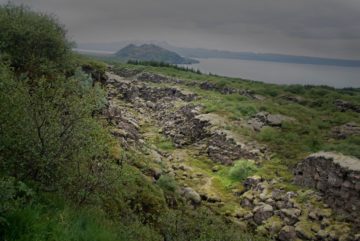
I
The boundaries between tectonic plates are where big things happen, lasting geologic things. They are among the most remarkable bits of land on earth. The mid-Atlantic ridge is one of those boundaries, the longest mountain range in the world, separating the diverging Eurasian and North American tectonic plates. Trouble is, it mostly lies undersea, so there aren’t many places you can inspect it.
In the Arctic there’s Jan Mayen Island. Farther south there’s the Azores, Ascension and St. Helena islands and the UK’s Tristan da Cunha way down in the middle of nowhere. And there’s Iceland.
As manifest in Iceland, to the east lies a raised lava ridge, the Eurasian plate, from which the North American plate, to the west, pulls up from the earth and apart.
The width of the point of contact varies. Just here it’s about a three foot deep grass covered crevasse. That’s a term mountain climbers use and it’s too dramatic for where I’m standing, really just in a ditch a little wider than your arms can reach. It’s pretty underwhelming, truth be told, bit it’s a historic ditch. A ditch full of history and portent. An auspicious ditch with worldwide ramifications.
Whatever you call it, it’s a singular place, a patch of grass you can jump down in and stand on a spot where the earth is coming apart. Elsewhere it’s twice the height of a man and filled with icy, transparent-as-the-ether water. Which is where we stop in a kind of Icelandic gulch.
“Now we are on the Eurasian plate,” our guide Sven says.
With a hop, “Now the North American.”
Hop. Europe. Hop. North America. You can change continents in Istanbul too but you have to drive across a bridge.
II
“Parliament” derives from the eleventh century Old French “parlement,” and every school child knows “parlez-vous Français” means “do you speak French?” so quite literally, a Parliament is a talking shop.
Turns out, even before they worked out a French word for it, way up in Iceland not just a word, but a real life parliament existed. “Thing” in Old Norse and Icelandic translates as “assembly,” and it is spelled “Þing” in Faroese and Icelandic. Resist the natural inclination to pronounce the letter (called “thorn”), written “Þ,” as “p.” Rather it is pronounced as an unvoiced “th.”
In modern Scandinavian tongues “thing” has become “ting.” The Faroe Island’s assembly began life as the Althing, a “general assembly of all free men,” and was later renamed the Løgting, “law assembly”. It began on the Tinganes peninsula in Torshavn, still the seat of Parliament and the city’s pride.
The Faroese Løgting and Iceland’s Althing carry on a rivalry to the claim of “world’s oldest Parliament.” You’d think the Faroese might logically claim the crown since expansion from the Norse mainland reached the Faroes before Iceland, but memory gets hazy when you gaze so far in the past, and there are partisans on both sides.
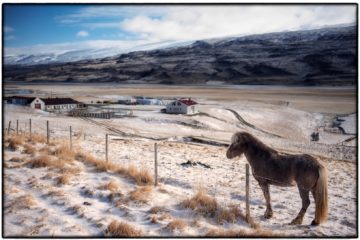 Iceland claims its Althing was the world’s first, established on the Þhingvellur plain in the overly-specific year of 930. There are other “oldest” claims. The Tynwald on the Isle of Man claims to be the oldest “continuous” Parliament at over age one thousand, but without a great deal of evidence. And the Jamtamót, the Parliamentary assembly of a Swedish province claims, like the Althing, to have been created in the first half of the tenth century.
Iceland claims its Althing was the world’s first, established on the Þhingvellur plain in the overly-specific year of 930. There are other “oldest” claims. The Tynwald on the Isle of Man claims to be the oldest “continuous” Parliament at over age one thousand, but without a great deal of evidence. And the Jamtamót, the Parliamentary assembly of a Swedish province claims, like the Althing, to have been created in the first half of the tenth century.
Whoever was first, a millennium ago, each year at the summer solstice, village chiefs from around Iceland convened on the Þhingvellur plain to discuss common interests and make policy. Though this plain was in a more or less central spot, those from farthest east Iceland invested as long as seventeen days – in summers so short you could just about oversleep and miss entirely – in a walk around mountain and glacier.
The base of a cliff served as a natural amplifier for speakers’ voices, allowing them to address the assembled. Each year, for two weeks in high summer laws were made, disputes settled, deals negotiated, foreign VIPs petitioned.
After that first meeting in 930 the Goði (chieftains, elders, priests, wise men, just modest but clear thinking sheep herders, most of them) convened on the same spot each year until 1798. History has played out for centuries at this place, Þingvellir, the “Parliament Plain.”
One particularly fateful meeting in 1000, 39 Goði came to Þingvellir, drawn away from their holdings during the brief lambing season because Olaf, the king of Norway, had issued a threat.
The wrath of his kingdom and the most fearsome war-fighting longboats in the Atlantic hung poised to impose holy hell if the Goði failed to accept Christianity, for this was the king’s demand.
Iceland’s founding some seven decades before came in flight from the tyranny and taxes of the Norwegian leader called Harald Fairhair. The original Goði, the men who set up the country, meant it to be a land of laws and not kings. That was why they were here at Þingvellir, to make their own laws, in the absence of a king.
These elders were reasonably confident the king wouldn’t risk his fleet in a peril-fraught adventure to Iceland. Frans G. Bengtsson summed up ancient political realism in The Long Ships: “… in the border country, few men’s authority extended beyond the limit of their right arm.”
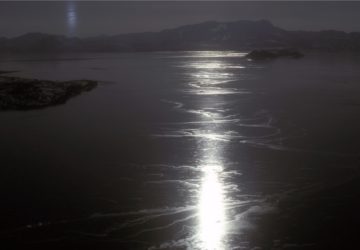 The Goði’s grandfathers hadn’t been wrong in fleeing Harald for the island. Icelanders benefitted from the lack of taxation Harald needed for defense. Still, the Norwegian fleet could block Iceland’s tenuous European lifeline. King Olaf held the sons of some Goði hostage even as they met.
The Goði’s grandfathers hadn’t been wrong in fleeing Harald for the island. Icelanders benefitted from the lack of taxation Harald needed for defense. Still, the Norwegian fleet could block Iceland’s tenuous European lifeline. King Olaf held the sons of some Goði hostage even as they met.
Legend tells us that as the men debated, a messenger arrived with word that an eruption had sent lava toward the farm of one of the attendees. That put a little bit of the fear of the Norse gods into the assembly. Message: the gods won’t stand for this changing religion nonsense.
Christianity had come to Norway after most of these pagan Icelanders left. Some learned of Jesus while passing through the British Isles (many absconding with wives). Synecretism led some to worship both the Christian and pagan gods, but in hard times in a hard land, Thor was still the go-to god.
So what to do?
Heads turned to a wise man called Snorri Þhorgrímsson, a chieftain from the west of the island. The Sagas reckoned him “… a very shrewd man with unusual foresight,” and “… the wisest man in Iceland not counting those who were prescient.”
Snorri asked, “What angered the gods when the lava burnt which we are standing on now?” He meant that eruptions were just part of life on their blasted isle, gods or no gods. The attendees saw his point. A vote was held and the Þing adopted Christianity as Iceland’s religion.
Besides, in accepting Christianity the most powerful men in Iceland surmised – correctly – that an appreciative hierarchy of Christian bishops and officials from Norway would look favorably on the Goðis’ power and rule.
In the event, the Þing had opted for the best of both worlds. Hoping to hold Harald at bay, the Goði proclaimed “one faith and one law” – the faith would be Christianity, but anyone wishing to worship the pagan gods were free to do so in private. Snorri had a church built at Helgafell, his farmstead on the western Snæfellsnes peninsula.
III
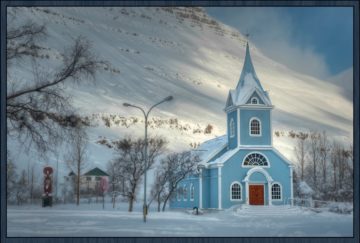 Everyone with power and influence attended the Þing. Crimes would be adjudicated, laws recorded, marriage alliances arranged, ties among the Goði forged and strengthened. But besides all that, and most marvelous of all, the Þing was a flourishing Nordic medieval bazaar.
Everyone with power and influence attended the Þing. Crimes would be adjudicated, laws recorded, marriage alliances arranged, ties among the Goði forged and strengthened. But besides all that, and most marvelous of all, the Þing was a flourishing Nordic medieval bazaar.
I try to conjure the spectacle of a Þing in progress a millennium ago; a governing experiment, societal pageant, a kind of grand plenum and Icelandic Burning Man, all tossed together and served on the volcanic plain.
Having come from far and wide, the chiefs would have brought an entourage of family, competitive athletes and horsemen, traders and cattle. Over the years they built structures of boulders and turf (ruins exist today) and each year they would cover them with temporary roofs of wood and more turf.
The Þingvellir was utterly unlike the attendees’ home villages. Just a few months ago back on the croft, the silence had been unrelenting (save for the howl when the wind got going, and the raking sleet across the roof); the nights went on and on, with stimulation scarcely more potent than the strength of a candle.
Now in high summer, headmen are free from home affairs, laborers from the dismal croft, and to a man, all were exhilarated by the runaway intoxication of it all: news of the welfare of kin. Gossip from the farthest ends of the island. Intrigue and time-worn lies told over mead. Barely mediated, ebullient chaos.
Every kind of merchant, sword-sharpeners and brewers, coopers and tanners and peat-cutters, clowns and tale-tellers held forth while itinerant farmhands sought seasonal work and traders probed for deals, some coming from abroad in search of exotic exports.
Villagers delighted at the smell of grilling meat and avoided the pungent atrocity of the tannery. Everywhere, in every direction, for days, Icelanders august and modest alike shared in the spectacle.
Athletes astounded. Ropes were tugged, cabers heaved, sheaves hurled, dice tossed and fortunes lost, challenges taken and gauntlets thrown, blood feuds resolved and new ones begun, all in a mad fervor to drink in life and all of it, in high summer, on this lovely spot, softened by greenery and painted by wildflowers with waterfalls and cascading rapids in the river Öxará swaying across the plain.
Stories are humans’ most enduring possessions. Since the campfire and the cave we are a narrative species, and the tales we tell shape the people we become. The tales of this country’s founding were told and retold year after year at the Parliament Plain, the hardships of the earliest settlers, the privation, the fights for survival.
Stories told at the Þing traveled home to every corner of the land, and over the years and through the retelling, a common heritage was born and the people’s allegiance was bound to the nation, which duly bound itself back to Þingvellir. By a 1928 law Þingvellir, by the river Öxará, shall remain the protected collective property of the Icelandic nation.
•••••
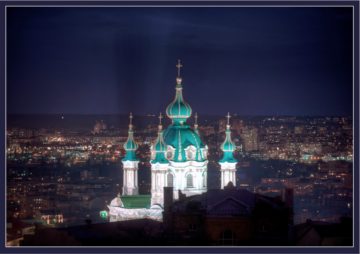 A personal note: eight years ago I published a sort of tour guide to Chernobyl, a short book I for visitors. Ukraine has been an abiding interest for me since, and my last 3QD column a month ago was about the then-looming war in Ukraine. Now that that war is, unbelievably, underway, I stand as a firm partisan of the people of Ukraine. The outcome of this conflict will surely rearrange the laboriously fought over pieces of what we used to call Post Cold War Europe.
A personal note: eight years ago I published a sort of tour guide to Chernobyl, a short book I for visitors. Ukraine has been an abiding interest for me since, and my last 3QD column a month ago was about the then-looming war in Ukraine. Now that that war is, unbelievably, underway, I stand as a firm partisan of the people of Ukraine. The outcome of this conflict will surely rearrange the laboriously fought over pieces of what we used to call Post Cold War Europe.
What emerges remains to be seen. But if you’re interested I invite you to follow events on a Twitter list I’ve built. It’s an entirely well-meant resource made up of ordinary Ukrainians and Ukrainian officials, officials elsewhere in the US and the EU, open source intelligence resources, think tank thinkers, ambassadors, interested parties in neighboring countries, reporters and always the odd rogue.
History is undoubtedly being written right now in Ukraine and we all have a stake in the outcome. If you’re following the conflict, you may find my list useful. It’s a constantly updated resource.
It’s here:
https://twitter.com/i/lists/1467909429534380034
